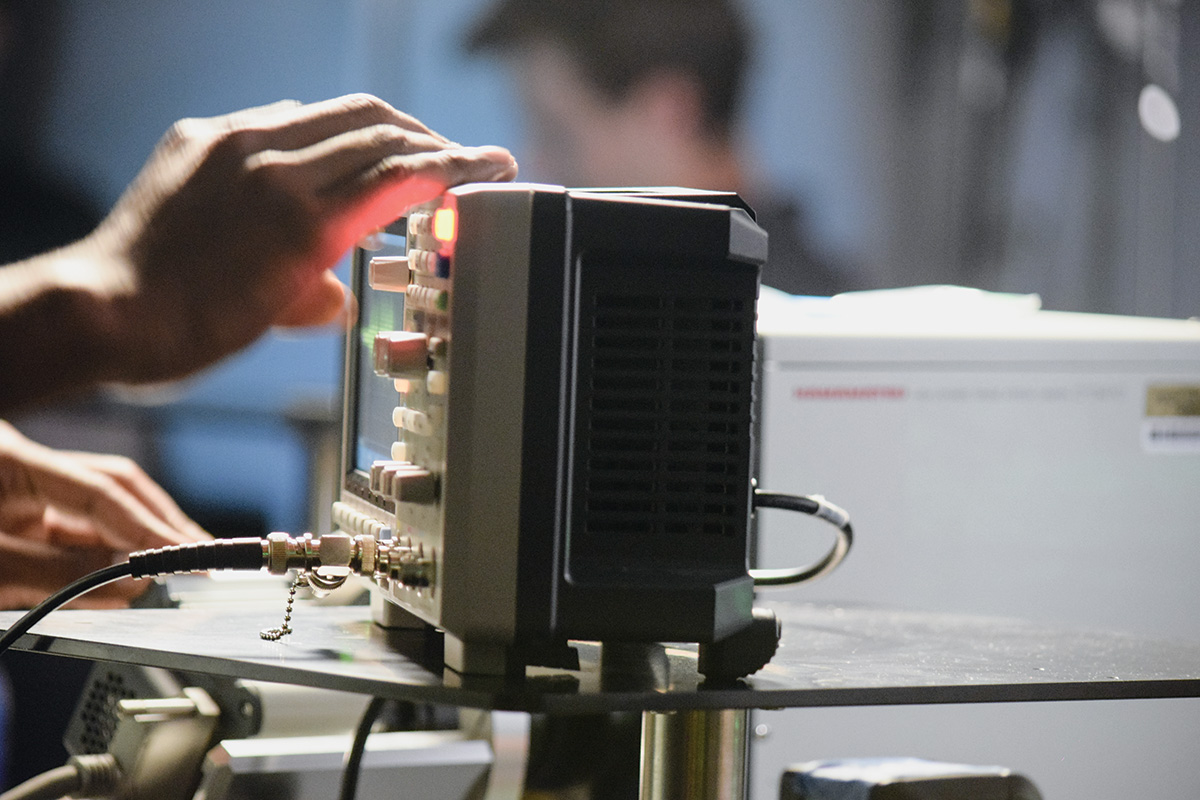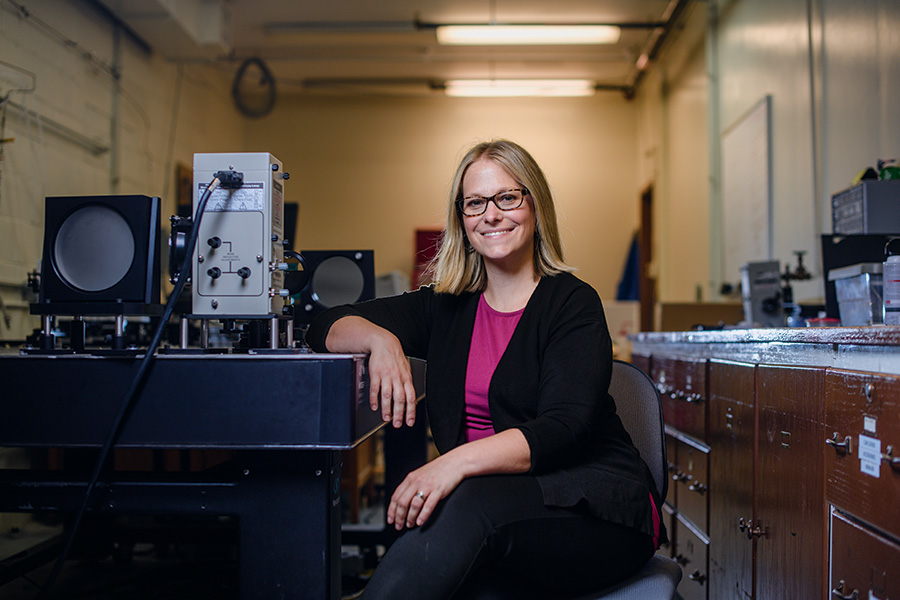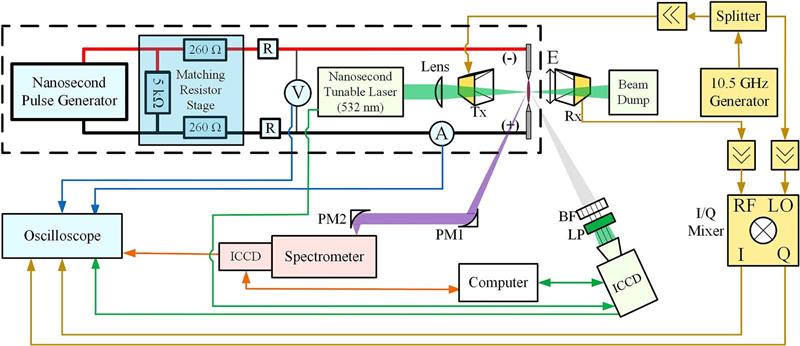There’s a lot still to learn about plasma. The energized state of matter has illuminated neon signs for more than a century, but precisely how it behaves is still an active area of research. This is especially true of plasmas produced in ultra-short, nanosecond-duration pulses that Purdue researchers have been honing for modern uses, including aerodynamic flow control.
Sally Bane, associate professor of aeronautics and astronautics, is taking a unique approach to getting a deeper understanding of why plasmas behave the way they do. Part of the mystery are the specific temperatures and the chemical composition of the energized gases in these experiments.
By combining multiple visualization technologies, and partnering with a laser-based diagnostics expert at Purdue, Bane is producing results in her fundamental research. The ultimate goal with her work is to provide data models that would pave the way for more precise use of these plasmas, in any situation.
"There’s a very broad range of applications of these plasmas. There’s the plasma antennas, flow control and combustion control that we’re researching here, but they’re also used in nanomaterial synthesis, and in some biomedical applications," Bane says.

Bane says that current computer models don’t have the ability to predict plasma behavior completely accurately. That’s the gap she’s trying to close.
"Like any of these physical processes, we like to be able to get on a computer and run a model and predict what the plasma is going to do. That way we can effectively design and tailor the plasmas for a particular application," Bane says.
Plasmas produced by nanosecond-duration electrical pulses don’t reach equilibrium in that short time. That means measuring the specific gas temperature, vibrational temperature and chemical composition in the tiniest instant is critical to producing better predictive models.
Bane’s work will translate her experimental measurements to the chemistry models needed for computer simulations.
"We’re measuring a whole bunch of very important parameters, and we’re measuring them with unprecedented temporal resolution, which you need because these plasmas are so short-lived."
—Sally Bane, Associate professor of Aeronautics & Astronautics
"On a baseline level, we don’t completely understand the underlying physics of these plasmas yet, particularly at high pressures, and so we can’t predict them with our numerical models. We are trying to bridge the gap with measurements that have not been done before," she says.

Sally Bane, associate professor of aeronautics and astronautics, is taking a unique approach to getting a deeper understanding of nanosecond-pulse plasmas. Her measurements will help explain why these short-lived plasmas are effective in various aerospace applications.
Bane’s specialty is optical emission spectroscopy, which involves analyzing the wavelengths present in the plasma’s light output to determine the gas temperature, vibrational temperature and chemical composition changes occurring within them.
"You need very fast, very accurate measurements of multiple quantities in order to create the chemistry models," Bane says. "On the other hand, if you want to implement plasmas in a large CFD [computational fluid dynamics] simulation, to explore aerodynamic flow control, you would typically model the plasmas as simple heat sources. And so we also need to know what temperature rise the plasmas are inducing, and at what times scales."
The fastest high-speed cameras available at Purdue’s Zucrow labs can capture an image in a bit less than a microsecond, or 10-6 seconds. But even those aren’t sensitive or fast enough for Bane’s needs.
A streak camera, on the other hand, doesn’t take a two-dimensional image you can hang on a wall. Instead, it records the intensity of light over time, which allows it to capture light data in picoseconds — or 10-12 seconds.
"With a streak camera, you can get down to a very, very small time resolution. The smallest time step that we’ve done is 25 picoseconds, which is tiny. But you also have to have to capture enough light so that you get a sufficient number of photons on the sensor," Bane says.
Bane, with support from the doctoral students she advises, feeds the camera output into a spectrometer in order to analyze the wavelengths present in these plasma light pulses. "From each of those spectra, we can learn something about the plasma. For example, we might be able to infer temperatures from that spectra, and then we’ll get a plot of temperature versus time for a single plasma within this time resolution," Bane says.
"No one’s been able to do that before," she says — a claim she published in the journal Applied Physics Letters in December 2021.

One of the limitations of optical emission spectroscopy is that second word: emission. If the samples don’t emit light, you need a different approach.
To get the broader scope of plasma behavior, Bane called for the help of Terrence (Terry) Meyer, a professor of mechanical engineering with a courtesy appointment to AAE.
"Terry is one of the preeminent people in the world on laser diagnostics for high-speed, turbulent flow and combustion," Bane says. "He and I are working to adapt some of his methods to this streak camera device that I’ve been working with."
With laser absorption spectroscopy, the basic approach is to pump energy into the material with a laser and analyze the light that is emitted back, Bane says. Meyer’s expertise in this area will allow them to study the plasma just before ionization and during the plasma decay, and measure other important quantities such as electric field and atomic concentrations. These measurements will provide finer resolution to computational models.
Though the tools individually aren’t groundbreaking, combining them to achieve these results certainly is.
"We’re measuring a whole bunch of very important parameters, and we’re measuring them with unprecedented temporal resolution, which you need because these plasmas are so shortlived," Bane says.
This research, funded by grants from the Department of Energy, has been some of her most fruitful work lately — leading to several conference and journal papers. Together with her co-investigators, including Meyer and AAE Professors Jonathan Poggie and Sergey Macheret, she is working to interpret the many new and interesting findings revealed by the experiments and to implement them in state-of-the-art plasma models.
Still, she approaches her innovations with humility.
"You know, we just took devices that already existed and combined them in a way that people hadn’t before. And then we just did a really, really good job of the optics so that we were able to take these really cool measurements."